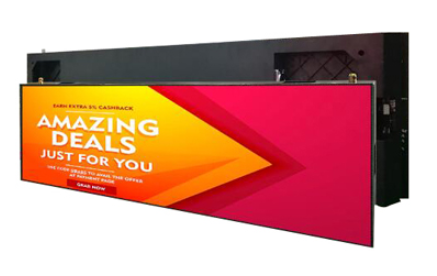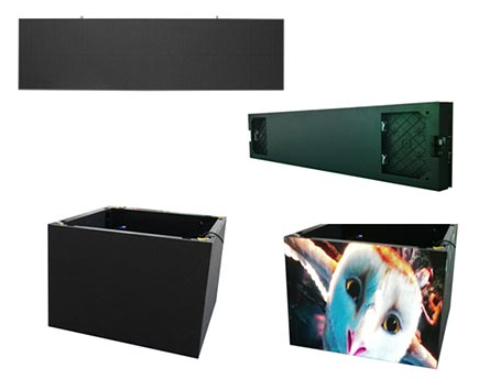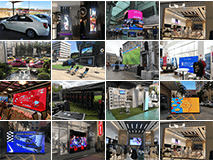Since its introduction decades ago, LED video wall display has made a substantial impact on how information is conveyed in a wide range of event environments. A variety of video wall technologies are now used in conferences, trade shows, educational settings and much more.

Understanding the Business Goals of Using a Video Wall
Before undertaking any visual implementation, the technology coordinator must consider the business goals associated with this strategy. How will a video wall improve and promote your message versus the promotion you're currently undertaking? For example, in an event environment, a video wall is extremely useful for displaying event sponsor content, directing attendees to various areas of the venue grounds and keeping guests entertained with engaging visuals, among other things.
Taking Advantage of Interactivity
While an interactive video wall isn't a necessity, it can make for a great end-user experience and enhance event engagement. You can implement interactivity into a video wall, either by using a touch display or via an application on a mobile device that augments the content.
Understanding the Space
Before even considering implementing a video wall, it's imperative that you understand the space that you'll be occupying. These factors will come into play when determining the appropriate size, brightness, pixel pitch, resolution and power requirements of the video wall you'll rent or purchase. Also, consider the other elements that will be present in the space - if you're setting up for a trade show and only have a small booth, a large video wall may be overpowering to attendees and detract from your main message.
Understanding Common Content Issues
ㆍThe general rule of thumb is to limit the length of video wall content to around 10 seconds. People aren't sitting down on their couch when they're at an event, they're dealing with a ton of distractions and are probably moving about - that's why it's important to present an easily digestible message.
ㆍWhen designing content, make letters large, at least a fourth of the screen and use a sans serif font. It's virtuously pointless to create shadows or shining effects on a three-inch letter that looks great on a computer, but isn't viewable on a video wall with spaced out pixels.
ㆍCreating visual hierarchy. Always put the most important part of your message at the forefront of what you show.
ㆍCreating a unified display. The main goal when implementing video wall technology is to create a unified display, not several individual screens that appear pieced together. Those black bars in between the screens can get very distracting and interrupt the flow of your content.

Understanding the Technical Capabilities of Video Wall Content
Videos, images, audio, text other content will need to be optimized for the type of video wall you're using. Nothing makes a video wall look more unprofessional than tiny, unreadable font and low-resolution images. Both should be large and clear enough to easily understand. Remember: Even though content looks awesome on a laptop screen, it might not translate to the hugeness of video walls. Always build video wall content with big screens in mind.
Understanding Pixel Pitch, Viewing Distance and Screen Resolution
Pixel pitch - which refers to the distance from the center of an LED cluster/pixel to the center of the next LED cluster/pixel, measured in millimeters, and directly correlates your display resolution - is key to a solid viewing experience.
Pixel pitch is important in determining minimum required viewing distance for a clear image. A smaller pixel pitch produces a higher-resolution video wall which the viewer can stand closer to and still see the content clearly. The higher the pitch is, the farther the required viewing distance. So, wouldn't you want smaller pixel pitch all the time? Not necessarily.
By having a smaller pixel pitch, you increase the number of individual pixels on a display. For example, a video wall larger than 100 inches with a 4-millimeter pitch can easily contain more than 200,000 pixels. A 6-millimeter pitch on the same size display would have fewer than 100,000. With the rise in pixels, comes a rise in cost. Fortunately, if your audience isn't going to be standing right next to the screen, you can reduce your pixel pitch and save your budget.
Understanding Brightness and Power
When renting or purchasing a video wall, it's important to consider the brightness level. First of all, will you need high definition LED video wall display indoor or outdoor? Direct sunlight can have very damaging effects on viewing quality if the brightness isn't properly set. In a similar vein, if the screen is too bright at night-time or when the lights are turned off, viewers can strain their eyes. Below are the guidelines for determining nit requirements (nit being the unit of measurement for LED brightness):
ㆍIndoor Brightness: 1,000 - 1,500 nits
ㆍOutdoor Brightness: 2,000 - 3,000 nits
ㆍOutdoor Brightness Under Direct Sunlight: LED panels may need to output as much as 5,000+ nits
Working with an Experienced Systems Integrator
Once you do decide on the best video wall for your event's needs, you'll need someone with experience operating displays. NSE can help you with the proper installation and mounting solutions, screen calibration and alignment, test and fix any poorly optimized content, as well as respond in the event of a technology crisis. Contact us now!

 English / America
English / America 简体中文 / 中国
简体中文 / 中国 Español / España
Español / España Italiano / Italia
Italiano / Italia













